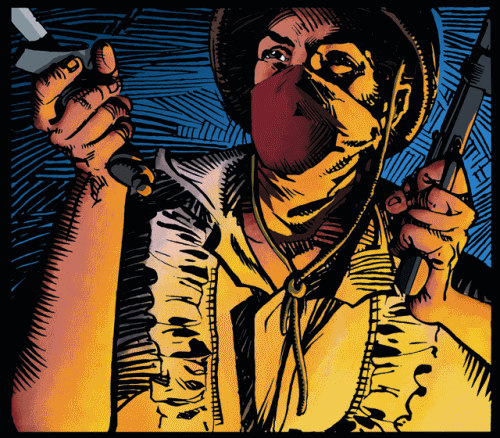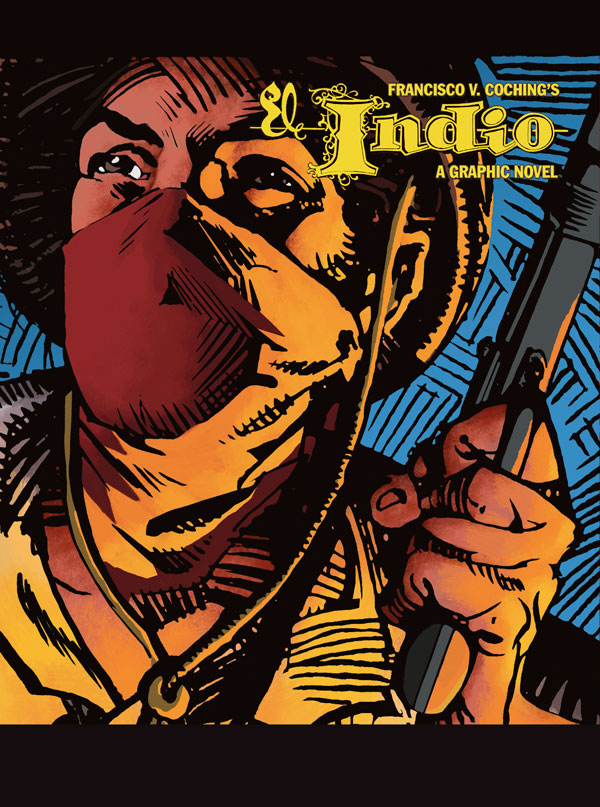
If you’ve been a regular visitor to this site, you’ve probably noticed I’ve been slowly acquiring the taste for graphic novels, as more and more of them seem to be making their way to my shelves.
Last week I had the chance to read Francisco V. Coching’s El Indio, a action adventure “komiks” (local comics) series first published in Pilipino Komiks back in the ’50s, which is said to be the golden age of Philippine comics, which flourished until the declaration of Martial Law in the Philippines.
Francisco V. Coching dominated this era of comics, hailed by general consensus as the Philippines’ greatest komiks illustrator, with 61 komiks novels, all but 10 of which were turned into popular films. El Indio is one of Coching’s most popular works, the sequel to the komiks “Sabas, Ang Barbaro.”
 El Indio is now out, for the first time, as a full-length graphic novel from Vibal Foundation, after a painstaking process of restoration by Filipino komiks artist and writer Gerry Alanguilan with the help of Zara Macandili — who had to scan original loose sheets of the comics, yellowed after decades, printing errors and manual repairs (pages taped over) and all.
El Indio is now out, for the first time, as a full-length graphic novel from Vibal Foundation, after a painstaking process of restoration by Filipino komiks artist and writer Gerry Alanguilan with the help of Zara Macandili — who had to scan original loose sheets of the comics, yellowed after decades, printing errors and manual repairs (pages taped over) and all.
“It required scanning at a very high resolution, zooming in, and pixel by pixel, fixing errors, erasing dirt, and adding black spots to where ink should have been. I’ve had to digitally redraw bits and pieces as best I could, to make damaged pages whole. I did not correct errors that Coching himself made, like lines and strokes going farther than they should. I wanted to remain as true as possible. My role was to try and decipher originals hidden inside every printed page,” Alanguilan reveals in his introduction.
El Indio is a swashbuckling adventure set in the period of Spanish occupation in the Philippines.
The story opens on a ship to Spain, where we are introduced to a young noblewoman, Blanquita Basco de Alava. It is soon revealed that Blanquita is pregnant, the child fathered by a rebel named Sabas (rough trans. = savage?).
Blanquita gives birth to Fernando, who, by his color, is obviously a mulatto, leading people to taunt him as “el indio,” in Spanish Colonial times a derogatory term for malay Filipinos, mostly based on their tanned complexion (mestizos were called Filipinos).
Even though he is of noble blood, Fernando grows up conscious of this discrimination because of his color and is thus compelled to show society just what the “el indio” can do — he becomes a great student, an excellent fencer, and a prizewinning matador.
When he learns about his paternity, he decides to seek revenge on his father, whom he believes abandoned him and his mother. After he wins a ship in a gambling match, he sails to the Philippines to find the rebel Sabas.
In Manila, Don Fernando becomes the toast of society, and he is enamored of the city’s belle of the ball, Victoria Rivera. He soon finds out that he has competition: the suave, older cavalry official Kapitan Martin Castillo.
Meanwhile, new rebel forces are in action to overthrow the seat government and Don Fernando soon becomes sympathetic towards their cause. He undergoes a series of tests to join the group (headed by a mystery leader) and wins for himself the “salakot” (hat) and “tabak” (cutlass) belonging to the legendary outlaw known as Barbaro (barbarian?).
Don Fernando slips into Barbaro’s role, taking on the new identity of “El Indio” and setting in motion a fiery series of events that causes mysteries to unravel.
Before El Indio, the only komiks I read (not counting the ones that came out in this decade like Zsa Zsa Zaturnnah and Trese) were the dregs of the once flourishing komiks industry, the ones I snuck reading when I was young (late 80s to early 90s) because they were our maids’ weekly reading fare and had graphic adult content (hahaha!). Printed on cheap newsprint (in funky technicolor, with a funky smell), they generally got thrown out with the rest of the newspapers after they had piled up.
I have also not read anything written in straight Tagalog in a very long time (not since I graduated from college I think) and it took me a while to get used to the intricate language, but after stumbling for a few chapters I soon got into it, save for the occasional obscure word. The writing is beautiful (and certainly more formal than any of us are used to today); and it’s a shame we don’t write or speak this way anymore.
I like the Filipino flavor too — the story is the stuff that’s always a hit with the general Filipino audience and I found it entertaining — the missing father, the love triangle, the anonymous ringleader, and the revolutionary theme. Parts of it strongly reminded me of Jose Rizal’s Noli Me Tangere, particularly the boating party, which is very similar to that one Ibarra and Maria Clara went on with their friends.
And of course, the art is just amazing — lots of expressive, dynamic strokes and great tonal values, and ornate details. While the panel layout is traditional, the perspective shifts in each panel, sustaining the visual interest from beginning to end. I haven’t read a lot of graphic novels but I haven’t seen art like this in any that I’ve read, and it makes me really curious about Coching’s contemporaries to see what kind of styles they used.
This revival of classic komiks is a laudable effort (awesome idea!), and it brings Coching outside the realm of hardcore komiks collectors and back into popular reading. I really appreciate the fact that El Indio has been made available for today’s readers, especially at a time when graphic novels are in vogue. While there are a number of Filipino graphic novels available today, El Indio definitely stands out as a representative of the komiks industry’s glorious past and as a beacon of inspiration to today’s komiks artists and writers.
I hear the publisher is planning to come up with some more komiks masterpieces — I can’t wait to read more of them! I do hope this release of El Indio inspires a second wave of the golden age of komiks in the Philippines — there’s certainly an audience out there, and I am now one of them!
***
My copy: paperback — available at leading bookstores for P600. Also available on Amazon!
My rating: 5/5 stars

yay! thanks for blogging about el indio :-) currently helping vibal foundation organize their library :-)
I also loved El Indio. :) Glad I bought it at the Komikon and I hope Vibal publishes more reprints from the Philippine Golden Age. But the main challenge of doing that is probably looking for the original art and restoring it. :(
Glad you’re getting into graphic novels. In relation to your post on postmodern picture books, comics offers endless potential for image-text relationships and page design. Some critics have referred to the comics page a “time map” – where, although images appear in sequence and represent discrete moments in time, they also exist simultaneously. So the potential for playing around with the page is endless. Winsor McCay was already doing it as early as the 30s in Litte Nemo.
Some recommendations, if I may:
– Jimmy Corrigan the Smartest Kid on Earth by Chris Ware
– Here by Richard Maguire (just 6 page, I can send you jpegs if u want)
– Notes on a War Story and Garage Band by Gipi
– Shortcomings by Adrian Tomine
– Goodbye Chunky Rice and Blankets by Craig Thompson
– Y the Last Man by Brian Vaughan and Pia Guerra
@Ms. Zarah – That’s cool! I work with the foundation too, for my day job :p
Ei Rommel! Thank you for the info and your recommendations – I am adding those books to my wishlist.
I have read some of Chris Ware’s work in the ACME Novelty Library compilation I have, and I have Goodbye Chunky Rice. Incidentally I’m also currently reading Blankets, on loan from a book club friend.
Will be blogging about Craig Thompson soon! :)
hope to read the thompson review :) unfortunately too much chris ware is i think terribly depressing. i have his sketchbook (ganda, he can draw realistic as well) and jimmy corrigan, which may be his best work. :)
the thompson review maybe next week. pa-email naman ng richard maguire! =)
really? we haven’t seen each other yet at the foundation :-)
just consultancy. we meet with them from time to time but mostly outside the office :)